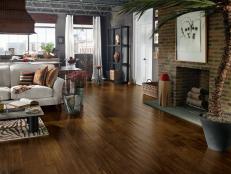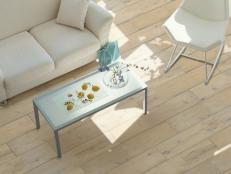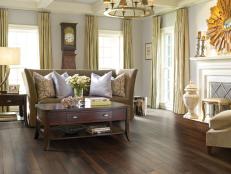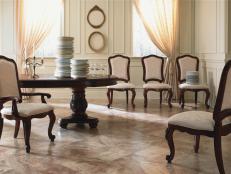Choosing Hardwood Flooring

Hardwood—just the word evokes images of charm, richness, and classic looks. Wood floors last a lifetime and gain "character" with age.
Options
Board Widths. Select from narrow strips (less than three inches), wider planks (more than three inches), parquet squares, and—a new option—squares and rectangles. The traditional choice, strips give the illusion of more space, while planks impart a rustic look. Parquet floors, with the distinctive geometric design, suit formal spaces.
Wood Species. Hardwood species vary in durability, grain patterns, and color. Oak, maple, and cherry are among the most common species due to their hardness. Exotic woods like mahogany, and Brazilian cherry aren't as durable, but are prized for their striking appearance.
Colors. Hardwoods run the gamut from blond to black, depending on species and finish.
Textures. You can get hardwood floors that look shiny and new, or you can buy brand new wood that looks like an antique and adds timeworn character to your room Many manufacturers offer distressed and hand-scraped hardwoods that will disguise heavy use over the years and give the floor an appealing timeworn appearance from the moment it's installed.
Hardness. For busy households with pets and kids, it's a good idea to choose the hardest wood species possible. Hard species, such as red oak, will withstand wear and tear, while softer species, such as pine, tend to show scratches. The choice between engineered and solid hardwood will most likely be determined by location, subfloor, and preferred installation method. But if you're on the fence, keep in mind choosing solid hardwood means scratches from a puppy's claws or dings from a toddler's toy can be sanded out and refinished over and over. Whichever you choose, preventive care and proper maintenance can keep your floors looking good for years.
Finish. Along with protecting the surface, hardwood finishes imbue floors with color and luster. Much commercially available hardwood comes prefinished, which simplifies installation and eliminates dust, chemical fumes, and waiting time. These factory-applied finishes generally have a longer warranty as they are longer lasting and more durable than site-applied finishes.
Some homeowners prefer site-finished floors due to the wider selection of stain colors and the opportunity to hone the surface and even out imperfections after the boards are in place. Boards are also easier to repair if damaged. Urethanes are the most common type of finish.
While solid hardwood can be repeatedly refinished, engineered hardwood flooring can only be refinished a limited number of times. That's because the thickness of the top veneer varies. However, prefinished engineered floors are quite durable, generally eliminating the need for frequent refinishing.
Hardwood Floors
See All PhotosFactors to Consider
Best for: Any room except full baths or laundry rooms.
Pet Friendly? Moderately. Keep pets' nails trimmed to avoid scratching the floor, clean messes immediately, and lay a mat under water dishes to minimize spills. The surface is hard, so provide soft mats or pet beds where dogs can lie down comfortably.
Underlayment. Underlayment products provide a base for the floor. This layer also limits noise, and adds insulation. Cushioned materials such as cork and form are ideal beneath floating floors. Vinyl- and plastic-lined underlayments are best in moisture-prone areas. Manufacturers offer many options and featuring a variety of benefits and price points.
Solid vs. Engineered
If you purchase hardwood floors, you'll need to decide between solid or engineered.
Solid hardwood is milled from a single piece of wood. Because it can be repeatedly sanded, it can last for decades. A natural material, solid hardwood is susceptible to temperature and humidity changes and cannot be installed below grade or in damp spaces. It must be nailed or stapled to a wooden subfloor.
Engineered hardwood is created by bonding layers of hardwood ("plies") together in a cross-grain construction. These layers give greater stability. Because it can withstand higher levels of humidity, engineered hardwood can be installed in baths and basements, as well as over concrete subfloors and radiant heating elements. Engineered hardwood uses fewer trees than solid hardwood. It can be stapled or glued, or it can "float" (affixed to itself rather than the subfloor).
The Lowdown
Hardwood is the gold standard of flooring surfaces and can add to your home's value. It's classic, durable and hypoallergenic. Solid hardwood floors can be refinished over and over and over again.
Keep in mind that hardwood floors can become dented or gouged, and they're susceptible to water damage. Also, engineered hardwood floors can be difficult to repair when damaged.
Hardwood typically costs between $3 and $10 per square foot, uninstalled. In general, installation should be left to professionals, although some manufacturers offer planks that lock together for glueless installation.







































